Startups Break New Ground at 2024 Industry Growth Forum
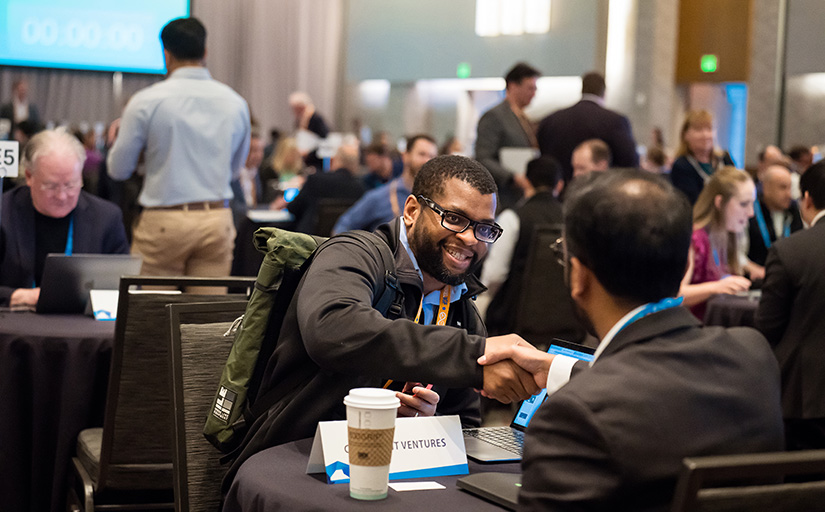
Maple Materials co-Founder and CEO Drew Reid meets with an investor during the 29th annual NREL Industry Growth Forum (IGF). Photo from Kira Vos
During the one-on-one meetings at the National Renewable Energy Laboratory’s (NREL’s) 29th annual Industry Growth Forum (IGF), Carbonova CEO and co-Founder Mina Zarabian explained that her startup company already had 24 customers in the pipeline. It made an impact on the investors she met with.
“We have a pilot plant that is up and running,” she said. “That’s enough for our customers to be able to test the product. And we have a major cosmetics company that wants to use our carbon nanofibers in creating sustainable packaging so it can decrease the amount of plastic it uses.”
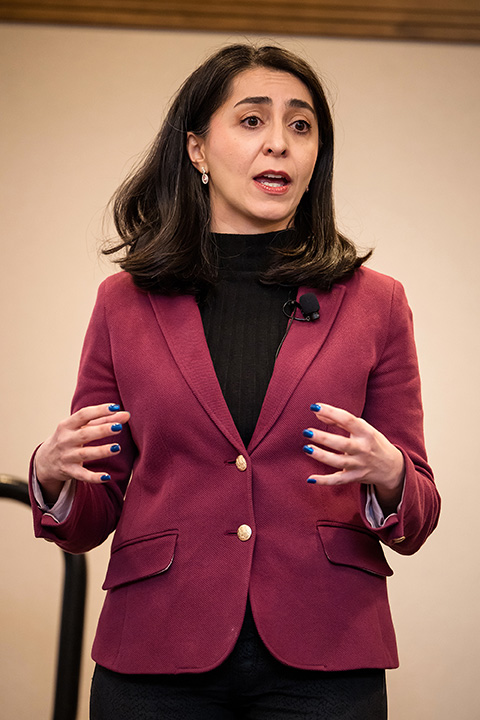
Carbonova CEO and co-Founder Mina Zarabian presents in the and Breaking Ground/Production-Scale Pilots Stage during the pitch competition during the IGF. Photo from Kira Vos
The theme of this year’s IGF was “Breaking Ground,” which Carbonova is embracing with its pilot plant. This was the second-straight year the IGF completely sold out before the event even began. Held at the Hyatt Regency in Denver, Colorado, on May 1–3, 2024, nearly 900 people attended from all over the world, including Canada, Singapore, and the United States.
“I can feel the excitement in the air,” NREL Innovation and Entrepreneurship Center (IEC) Director Trish Cozart said during her opening remarks. The IEC runs the annual event. “All the possibilities and pent-up potential. We’re here to break new ground together. Welcome to several days of what I think are some of the most inspiring of the whole year.”
A total of 364 startup attendees used the event as an opportunity to meet with 257 investors. Preselected startups also vied for top prizes in a pitch competition.
“We all need to move faster,” NREL Director Martin Keller told the assembled group of startups, investors, and industry professionals. “It took 30 years for solar to get to where it is now, but we don’t have another 30 years for advancement. Climate-tech investors at the IGF plan to invest about $7 billion over the next 12 months, and this event is to help you get some of these important funds to go to the next level and accelerate your work.”
The highlights of the IGF are the one-on-one meetings that take place between startups and investors, where they conduct up to 12 back-to-back meetings, each with 10 minutes to connect. This year featured nearly 1,500 meetings during the formal session and more than 1,600 meetings in the ad-hoc sessions. For many, it is what makes the IGF a must-attend event for startups in this space.
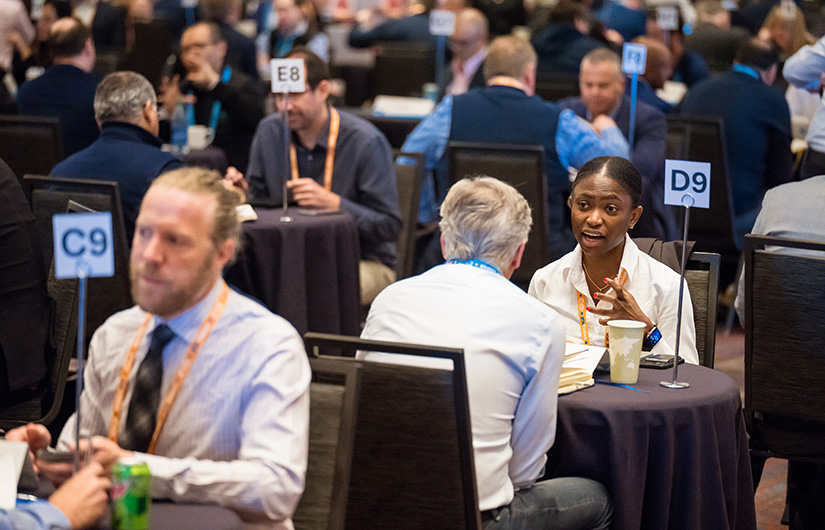
This year’s IGF featured nearly 1,500 meetings during the formal session and more than 1,600 meetings in the ad hoc sessions. Photo from Kira Vos
The IGF enables NREL to convene leading climate-tech investors and the most promising emerging startups, creating a dynamic network that keeps NREL at the forefront of technology commercialization. The clean energy transition will not and cannot be a solo endeavor—NREL needs the assistance of industry partners and investors.
Growth in Climate-Tech Manufacturing and Construction Financing
Advancing from the early-stage venture capital ecosystem into clean energy infrastructure and manufacturing investments, 2023 was a record-breaking year. Experts believe that trend will continue.
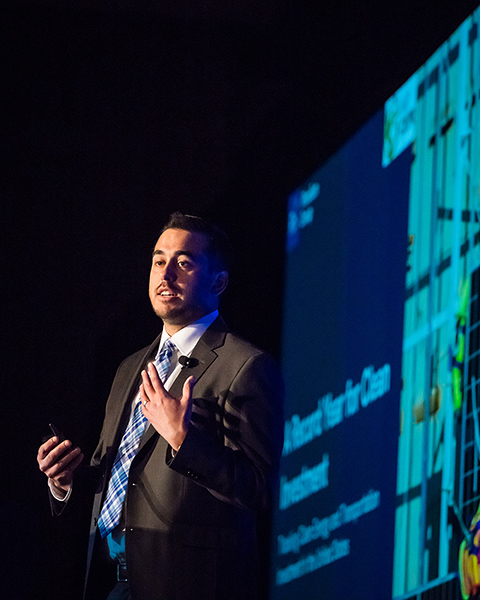
Mike Delgado, director of energy and climate research for the Rhodium Group, told the crowd at the IGF that investments in clean transportation, energy, and manufacturing plants, equipment, and goods represented 5% of all fixed-asset investment in the United States in 2023. Photo from Kira Vos
During the Thursday morning session, Mike Delgado, director of energy and climate research for the Rhodium Group, discussed tracking clean energy investments in the United States. Investment in clean manufacturing, energy and industrial facilities, and products reached $239 billion in 2023, up by 38% in one year and more than three times what it was in 2020. Investments in clean transportation, energy, and manufacturing plants, equipment, and goods represented 5% of all fixed-asset investment in the United States in 2023—literally breaking new ground across the country.
“The growth in clean investment has been so large and so continuous that it’s an extremely effective buoy of economic growth,” Delgado said. “There was a $48 billion investment in clean manufacturing in 2023—23 times the size it was five years ago. It’s becoming a major driver in the overall landscape.”
Delgado said the problems with the supply chain during the pandemic helped make that happen, as U.S. industries realized they need to have more supplies produced domestically. He also said that while the federal government aids climate tech, it is overwhelmingly a private-capital story.
“There was $220 billion in total investment last year and $34 billion from the federal government,” Delgado said.
Additionally, many of the new factories for climate tech are breaking ground and opening in states with the potential to reactivate a traditional energy workforce, especially in communities near closed coal plants or those with higher-than-average rates of unemployment and a legacy of fossil fuel development.
Pitch Competition
Each year, 40 startups in four different stages compete for the highest scores from judges in the pitch competition: Early Stage, Commercialization Stage, Growth Stage, and Breaking Ground/Production-Scale Pilots Stage. For the latter, all companies were working on pilot presentations or demonstrations. That is where Carbonova competed.
Carbonova creates solid carbon nanofibers from captured carbon dioxide (CO2), instead of from oil or graphite. These nanofibers are then incorporated into plastics, rubbers, inks, and electronics.
“The CO2 is captured in an industrial area and bottled and delivered to our facility in a storage tank,” Zarabian said. “We use a chemical process with the help of a catalyst to separate carbon and water. With the steam, we recover energy from the process, and then the heat can be reused for the process itself so it can heat up the reactants and start the process.”
Because of the existence of customers waiting for its product, many of the investors Zarabian met with during the one-on-one meetings wanted to follow up with Carbonova in the future.
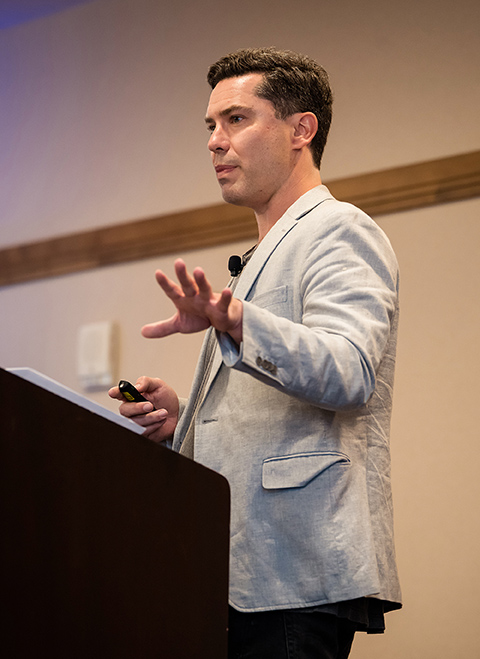
Living Ink Technologies CEO and co-Founder Scott Fulbright delivers his presentation during the pitch competition at the 29th annual IGF. Photo from Kira Vos
Living Ink Technologies, also a competitor in the Breaking Ground/Production-Scale Pilots Stage, wants to change how carbon black is made. It is used in almost anything that is colored black—like ink, plastic, or tires—and traditionally it takes oil and construction to make carbon black.
“For every kilo of carbon black Living Ink Technologies makes, we’re sucking up about 4 kilos of CO2 from the atmosphere for every kilo of pigment we make,” said Stevan Albers, Living Ink’s chief technology officer and cofounder. “Most carbon black creators emit that much per kilo. We’re not only cancelling that but removing CO2 from the atmosphere.”
Living Ink partners with a company in California that extracts blue pigment out of algae. Living Ink takes the leftover algae to create carbon black. The startup is also moving into using yeast cells discarded after brewers use them.
Maple Materials co-Founder and CEO Drew Reid also caught the attention of several investors during the one-on-one meetings. Like Carbonova, Maple Materials works with captured CO2, but this startup turns it into graphite materials for lithium-ion batteries.
“We’ve developed a patented electrolysis process that uses molten salt,” Reid said. “When we run electric current through that salt, we’re able to separate the carbon and oxygen at a molecular level. Forming graphite is just taking the carbon and arranging it into a crystal structure with a honeycomb pattern.”
Maple Materials is building a pilot facility in Richmond, California, to demonstrate the industrial potential of the process at scale.
One-on-One Meetings and More
“The one-on-one meeting session was excellent,” Zarabian said. “I met with around eight companies or venture capitalists (VCs). Most of them were interested themselves, or they had another investor in their network they wanted to introduce me to.”
After Zarabian’s pitch presentation in front of the judges, a potential customer spoke with her, interested in using Carbonova’s product for composite applications.
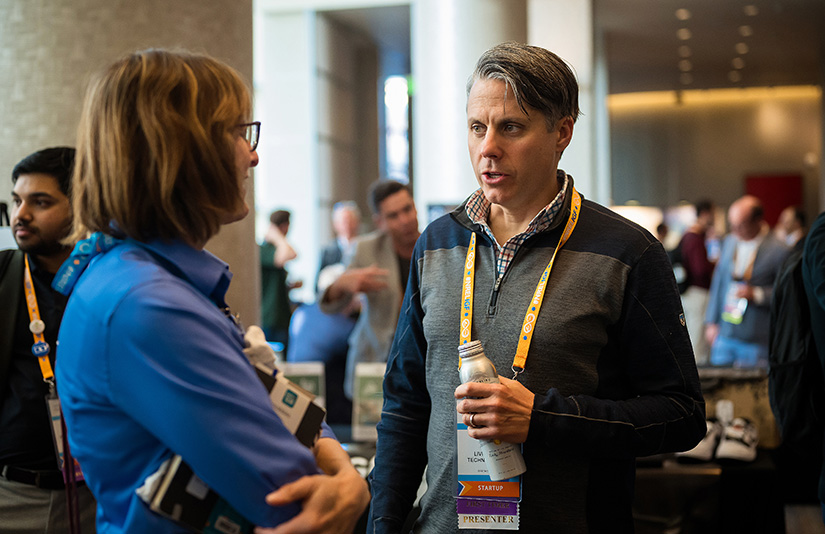
Stevan Albers, Living Ink Technologies’ chief technology officer and cofounder, meets with investor Sally Hatcher in the exhibition hall in front of Living Ink’s booth. Photo from Kira Vos
Living Ink Technologies CEO and co-Founder Scott Fulbright and Albers got through 10–12 meetings on Thursday and had several more on Friday morning.
“We had a few investors that thought we weren’t right for them, but when we sat down and they learned more about what we do, they got very interested,” Fulbright said. “They said, ‘We’ve got three different areas we’re interested in, and you’re working on all three of them.’ What we accomplished—I don’t know how else you get to do that without having the one-on-one sit down.”
Fulbright said he and Albers connected with new leads and met others they began working with two years ago, but this was the first time meeting them in person.

Nearly 900 people attended the IGF from all over the world, including Canada, Singapore, and the United States. Here, investor Naynika Chaubey greets a startup seeking investment in the one-on-one meetings. Photo from Kira Vos
Reid felt he connected with a number of investors during the one-on-one meetings that will hopefully lead to investment, strategic partnerships, and long-term relationships. He was especially excited about another startup with an application that can help Maple Materials’ process, as well as a meeting with an oil and gas conglomerate that could be an investor, supplier, and customer all at once.
Award Winners
At this year’s IGF, the judges gave out more awards than ever before, with a first and second placement in the Early Stage and Commercialization Stage categories.
This year’s award winners:
Outstanding Venture—Early Stage
- 1st place: Aryton Energy, Alberta, Canada
- 2nd place: Otoro Energy, Boulder, Colorado
Outstanding Venture—Commercialization Stage
- 1st place: Mitra Chem, Mountain View, California
- 2nd place: Mycocycle, Bolingbrook
Outstanding Venture—Growth Stage
- 1st place: CleanFiber, Buffalo, New York
Outstanding Venture—Breaking Ground/Production-Scale Pilots Stage
- 1st place: Living Ink Technologies, Berthoud, Colorado
Best Venture Award
- Queens Carbon, Pine Brook, New Jersey
People’s Choice Award
- Adena Power, Lewis Center, Ohio
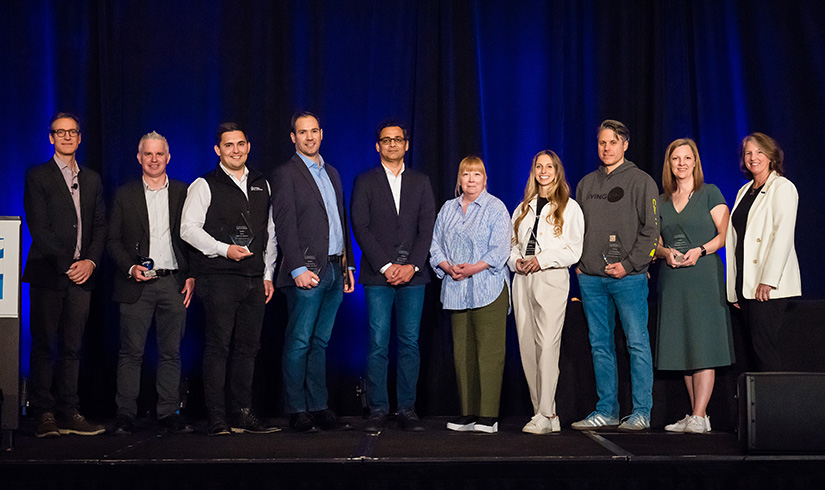
At this year’s IGF, the judges gave out more awards than ever before. Photo from Kira Vos
Fulbright was already on a plane during the awards ceremony, so Albers accepted on behalf of Living Ink Technologies.
“It means we’re on the right track,” Albers said. “Hopefully it will translate into some good new connections and into some stronger existing connections. We weren’t worried about trying to win, but it’s a cool award and great to be recognized. We’re honored to be here and be recognized for our work.”
The Future
While this was Zarabian’s first visit to the IGF, it likely will not be her last.
“I should have come years ago,” she said. “I wish I knew about it earlier because I could have found the right firm for us and already be in their pipeline. But several are interested in being the lead investors for our next round of fundraising. The IGF is fast and dynamic. Something is always happening somewhere, but it’s very organized and everything is on time.”
Fulbright, also a first-timer at the IGF, was very impressed by the attendees.
“I think the IGF is great,” Fulbright said. “The number of attendees and the quality is the highest I’ve ever seen before. It’s great to see so many people in this area.”
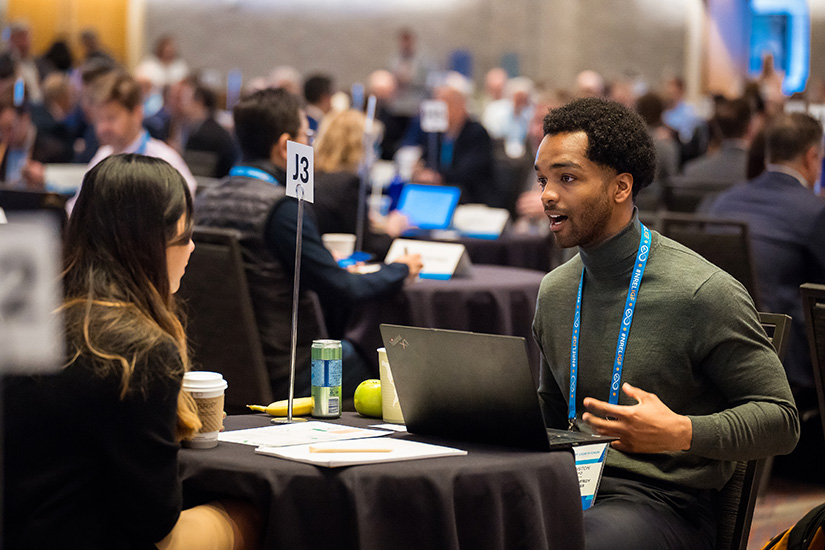
Investor Wynston Reed meets with a startup in the one-on-one meetings. Next year’s IGF, the 30th anniversary of the event, is set for March 26–28, 2025, in Denver, Colorado. Photo from Kira Vos
During her closing remarks, Cozart reminded the crowd that even though major challenges lie ahead, it is crucial that the clean energy transition continues.
“It’s going to take a lot to deploy new technologies,” Cozart said before giving out the awards. “If it was short, we’d call it the energy switch, not the transition. It’s dirty, it’s messy, and it’s muddy, but we’re here to help build those connections so we can break ground even faster. We want to pick up our shovels and dig in and really work with you.”
Reid hopes that when he returns to future IGFs, the event keeps the same feeling and spirit.
“It’s really incredible that so many people are here, but this still feels so personal,” Reid said.
Next year’s IGF, the 30th anniversary of the event, is set for March 26–28, 2025, in Denver, Colorado. To learn more, visit nrelforum.com.

